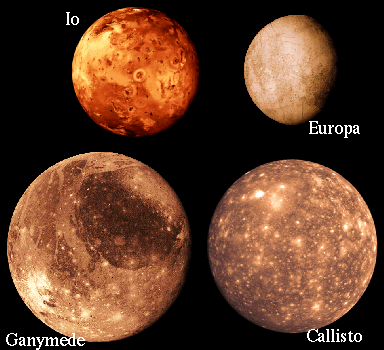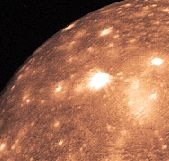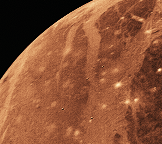The Galilean Moons of Jupiter
 Galileo's Moons
Galileo's MoonsGalileo discovered in 1610 Jupiter's four large moons (starting from the closest in) Io, Europa, Ganymede and Callisto, now known as the Galilean moons. All the Galilean moons are comparable in radius to Earth's moon, though have a varied density (indicating varying ratios of rock and ice).
The Galilean moon system was the first discovery of a center of motion not apparently centered on the Earth. It was a major point in favor of Copernicus's heliocentric theory of the motions of the planets; Galileo's outspoken support of the Copernican theory got him in trouble with the Inquisition.
Jupiter and its Moon's have been visited by several spacecrafts, beginning in the early 1970s by Pioneer 10 and later by Pioneer 11, Voyager 1, Voyager 2 and Ulysses. The spacecraft Galileo is currently in its 8th year of a mission to study Jupiter and its moons. The spacecraft is now nearly out of the hydrazine propellant needed to keep its antenna pointed toward Earth. On Sept 21, 2003, it will die a spectacular death when it plunges into Jupiter!
 Callisto (1.9 Million km from Jupiter)
Callisto (1.9 Million km from Jupiter)
Very low density. Callisto seems to have little internal structure; however
there are signs from recent Galileo data that the interior materials
have settled partially, with the percentage of rock increasing
toward the center. Callisto is about 40% ice and 60% rock/iron.
Callisto's surface is covered entirely with craters. The surface is
very old, like the highlands of the Moon and Mars. Callisto
has the oldest, most cratered surface of any body yet observed
in the solar system; having undergone little change other than
the occasional impact for 4 billion years.
Callisto has a very
tenuous atmosphere composed of carbon dioxide and shows evidence of
a weak magnetic field.
 Ganymede (1.1 Million km from Jupiter)
Ganymede (1.1 Million km from Jupiter)
Largest of Jupiter's moons and the largest satellite in the solar system.
It is larger in diameter than Mercury but only about half its mass.
Ganymede is much larger than Pluto. Ganymede is differentiated into
a three layer structure: a small molten iron or iron/sulfur core
surrounded by a rocky silicate mantle with a icy shell on top.
Ganymede's surface is a roughly equal mix of
two types of terrain: very old, highly cratered
dark regions (left), and somewhat younger (but
still ancient) lighter regions marked with an
extensive array of grooves and ridges (right).
Their origin is clearly of a tectonic nature, but the
details are unknown. Extensive cratering is seen on both types
of terrain. The density of cratering indicates an age of
3 to 3.5 billion years, similar to the Moon.
Ganymede has its own
magnetic field embedded inside Jupiter's huge one, suggesting
conducting material in Ganymede's interior. Ganymede may
have a very tenuous oxygen atmosphere, but this is not
a sign of life.